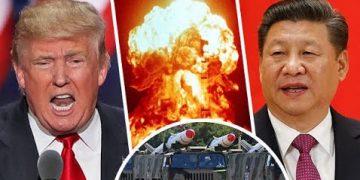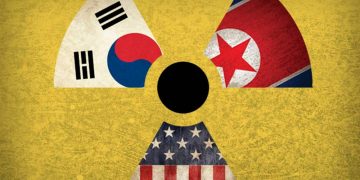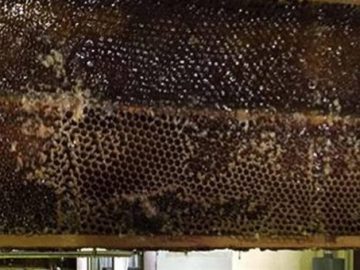North Korean president Kim Jong Un, after the latest testing of a ballistic missile, stated that his country is now a nuclear power in the true sense of the word.
North Korea’s latest test of an intercontinental ballistic missile (ICBM) showed that the country now has the capability to strike the entire United States — and there’s little that the USA can do to stop it.
The test revealed just how dramatically North Korea’s missile program has advanced over the past year, and how much more of a threat the country now poses to the US. In April, Pyongyang tested a missile that blew up just seconds after launch. Tuesday’s missile, however, flew more than 10 times higher than the International Space Station, and was in the air for 54 minutes before landing near Japan.
The North Korean missile advances are happening despite pressure from the international community, which continues to slap economic sanctions on the country. President Donald Trump is expected to impose new financial restrictions on Pyongyang Wednesday, just one week after the US increased penalties when it put North Korea back on the state sponsors of terrorism list.
On top of that, North Korea tested its most powerful nuclear bomb ever on September 3, and it may have stockpiled up to 60 nuclear weapons. Making matters worse, the US military believes North Korea already has the capability to “miniaturize” a nuclear weapon and fit it onto that missile, which it could then use to hit major US cities like Washington, DC.
Trump National Security Adviser Herbert MacMaster stated “North Korea is the biggest imminent threat to the United States,” and added that the chances of a break out of a nuclear war with this country are increasing every day.
Now the question that arises is whether the United States with a pre-emptive attack can neutralize North Korea’s nuclear capabilities. According to experts, this is hardly feasible because North Korea is primarily a mountainous country and its nuclear facilities have been concealed underground throughout the wider territory.
Failure to neutralize the North Korean nuclear facilities would pose a dangerous exposure of South Korean and Japanese residents to missile and nuclear attacks, and it is a priceless scenario that Washington, Seoul and Tokyo want to escape at all costs.
“Any attack on the United States, or even limited, will mean only one thing for for North Korea – an introduction to a larger attack. In such a case, Kim will not hesitate to use nuclear weapons, ” said analyst Geoffrey Lewis.
To destroy North Korea’s artillery and its missiles and nuclear program, an invasion at all levels is necessary. However, any sign of immediate assault – such as the piling up of American forces, the mobilization of South Korean and Japanese troops, or the evacuation of US citizens in that region – could make Kim Jong Un order a pre-emptive attack.
“In reality, the war is something to be avoided, because the analyzes show that this kind of collision is crazy,” said analyst John Delori.
The North Korean army is likely to attack Seoul first, as it is easiest to trigger border artillery. They will immediately attack the South Korean, Japanese and American bases. No one knows if North Korea could hit any US city with a nuclear missile, nor would the Americans be able to defend themselves.
South Korea is an economically powerful country, accounting for 2% of the world’s economy and this country has the headquarters of global companies such as Samsung and Hyundai, which is why an eventual war will affect the economy in the region and throughout the world. Experts estimate that in case of war, the global financial market will suffer the most, but that the value of Swiss francs and gold will grow.
If just assume for the sake of argument that North Korea can reliably fire a nuclear missile that could make it all the way to the US.
Would we be able to shoot it down?
The answer, it turns out, is “probably not.” The US does have a missile defense system in place to protect itself. However it’s imperfect at best because it basically works like this: if a country shoots a missile in our direction, America launches its own interceptors — that is, missiles — to destroy the hostile weapon in the sky. This is why some people refer to missile defense as “hitting a bullet with another bullet.”
Experts claim that the US has a total of 44 interceptors stationed in Alaska and California that could be used if North Korea shot at America.
In May, the US had their biggest success yet when they tested the missile defense system under realistic conditions: rockets launched from California destroyed the incoming mock ICBM in midair.
The problem, though, is that these tests were carried out under highly controlled conditions. As Lewis stated, the “target was fired right at the interceptor on a nice sunny day with lots of warning.” But in an actual warlike scenario, the US will not dictate the conditions. If an actual attack happens, there will likely be some warning, but the US may not be fully confident where the missile is headed or what kind of ICBM.
Another bad news is that the missile defense system has only passed 10 of 18 tests, Kingston Reif, according to the director for disarmament and threat reduction policy at the Arms Control Association.
“Depending on the trajectory, we should not assume that we can, with any reliability, intercept ICBM warhead targets,” says Vipin Narang, a nuclear expert at MIT.
The last two tests of the ground based interceptors have been successful despite a spotty track record previously. “I’m very confident…that this system can and will defend the homeland if attacked,” said the former head of the U.S. Missile Defense Agency, Vice Adm. James D. Syring.
To protect South Korea and the U.S. territory of Guam, the U.S. military has deployed the THAAD anti-ballistic missile system. Currently THAAD (Terminal High Altitude Area Defense) is only operated by the United States military, but there are only a few systems available to deploy.
“The United States has only about five or six [THAAD] batteries for the world,” said Karako.
“The United Arab Emirates has two THAAD batteries and the Saudis have announced they will be purchasing seven batteries,” Karako said.
THAAD is a perfect 15 for 15 over its lifetime in controlled tests to destroy short or medium range ballistic missiles, including two recent tests from Kodiak, Alaska which shot down ballistic missiles over the Pacific. THAAD missiles intercept ballistic missiles when they re-enter the Earth’s atmosphere.
“North Korea has hundreds of missiles, the THAAD battery is not there to defend the entire peninsula,” said Karako. “This is not about having a perfect shield and sitting there and playing catch.”
This week, the U.S. Army added four more launchers – over the objections of Russia and China – to join the two already in place bringing the total now to 48 missiles to defend South Korea.
Japan does not have the THAAD system.
Sitting off shore are Aegis destroyers that are designed to shoot down ballistic missiles outside the atmosphere in space.
Protecting Japan are Patriot missile batteries to provide a last ditch protection should any missiles get through the Aegis warships deployed at sea.
The aircraft carrier USS Ronald Reagan was put to sea this morning from Tokyo Bay for preplanned training exercises at sea, according to the U.S. Navy.
Separately, a ballistic missile defense warship will always be on alert near Japan. Defense Secretary Jim Mattis will join the president and the rest of the cabinet along with their families at Camp David this weekend.
And on Friday, a US Navy official confirmed that four warships had joined the USS Ronald Reagan at sea for a “routine patrol,” just a month after the aircraft carrier’s month-long maintenance period in Japan. The official says that two of the four warships are ballistic missile defense ships capable of shooting down North Korean missiles. The four warships carry more than 100 Tomahawk cruise missiles among them.
Ahead of a meeting with Kuwaiti Deputy Prime Minister and Defense Minister Sheikh Mohammed Al-Khaled Al-Hamad Al-Sabah at the Pentagon Thursday, Defense Secretary Mattis was asked by a reporter what would happen if North Korea fired a missile at the United States or threatened any allies this weekend.
However, Trump has three options for dealing with North Korea, and none of the is good.
Military strikes (incredibly dangerous)
Military option experts believe would do far more harm than good. “North Korea’s programs are too sophisticated and dispersed to think that we could destroy them with military strikes, never mind the devastating regional retaliation that would ensue,” Mira Rapp-Hooper, an Asia security expert at Yale Law School, said in an interview. “You cannot bomb away scientific knowledge, and North Korea’s quick indigenous developments indicate that this knowledge runs deep.”
If the US believed North Korea was about to attack first, Trump could launch a preemptive surgical strike on North Korea — narrowly targeting the country’s missile and nuclear sites without causing too much damage beyond those few sites.
That would certainly address the immediate threat to the US, but North Korea would almost certainly retaliate — potentially imperiling the safety of not just Americans but millions of people in South Korea and Japan. Indeed, most experts believe that those two countries would be the first targets of Kim’s wrath should the US attack.
Simulations of a large-scale artillery fight produce pretty bleak results. One war game convened by the Atlantic back in 2005 predicted that a North Korean attack would kill 100,000 people in Seoul in the first few days alone. Others put the estimate even higher. A war game mentioned by the National Interest predicted Seoul could “be hit by over half-a-million shells in under an hour.” Those results don’t bode well for one of Washington’s closest allies, or for the 25.6 million people living in Seoul.
None of this even factors in the large-scale refugee crisis that a war would create, where millions would flock north to China as their homes and livelihoods are ravaged by war. That’s something China expressly does not want.
Diplomacy
So far the Trump administration has avoided striking North Korea, preferring to pursue a strategy Trump officials call “maximum pressure and engagement.”
“While diplomacy is our preferred means of changing North Korea’s course of action, it is backed by military options,” Secretary of Defense Jim Mattis and Secretary of State Rex Tillerson wrote in an August 13 op-ed. “The US is willing to negotiate with Pyongyang. But given the long record of North Korea’s dishonesty in negotiations and repeated violations of international agreements, it is incumbent upon the regime to signal its desire to negotiate in good faith.”
Clearly, that approach hasn’t worked so far. But to be fair, diplomacy hasn’t worked for past administrations either.
America has tried to come to some sort of diplomatic, negotiated agreement with North Korea over its programs since 1985, according to the Arms Control Association. But on each occasion, talks between the US, North Korea, and other world powers collapsed because North Korea walked away. However, experts tell me it was unlikely Kim would have given up his country’s missile and nuclear programs.
The Kim family, which has been in power since Kim Il Sung took charge in 1948, has seen what happens to leaders who don’t have nuclear weapons. In modern times, Iraq’s Saddam Hussein persuaded much of the world that he had restarted his country’s nuclear weapons program; he hadn’t, but the boasts helped spark the 2003 invasion that drove him from power. In Libya, Muammar Qaddafi gave up his program to build closer ties to the West, but was eventually ousted from power and killed by a mob.
So Kim Jong Un, Kim Il Sung’s grandson, has no incentive to stop any of its programs. In fact, he has incentives to keep them going.
Economic sanctions
There are sanctions, which are meant to financially cripple Pyongyang to the point that it would enter into negotiations with America and others to curb its nuclear program. The problem is sanctions tend to work much better before a country obtains what it wants – Sheena Greitens, a North Korea expert at the University of Missouri.
In this case, North Korea achieved a big step toward its goal of having a missile that can carry a nuclear weapon to America’s largest cities. It’s going to be hard at this point to use sanctions to change the North’s behavior when Pyongyang feels like it is so close to the finish line.
Some experts think that, at this point, the US should just accept that North Korea has nuclear weapons. Instead of trying to get the country to give them up, we should work to contain the damage a nuclear North Korea could wreak.
But it seems that the president will take that advice. He promised he would not allow North Korea to develop a missile that could bring a nuclear weapon to America.
It turns out that North Korea likely has that ability now, and if not, it will soon. That means Trump — and all of us — are stuck with the danger North Korea poses for the foreseeable future.




































Connect with us